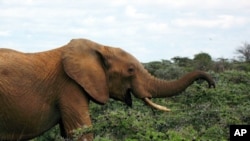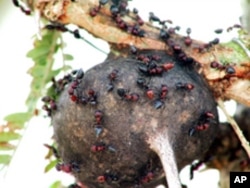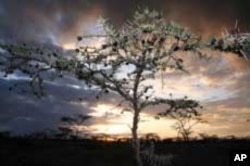A David and Goliath story is playing out on the African savanna, where tree-loving ants are fending off herds of tree-hungry elephants, proving that - in nature - size and strength don't always triumph.
Florida biology professor Todd Palmer studied the curious interaction between ants and elephants in one area of the savanna in Kenya where the Acacia are thriving.
The plant has a tough time taking root because of the thick clay soil and the threat of roving elephants who dine on the trees' leaves and bark, leaving many stripped bare.
Tree bodyguards
"The elephants weren't touching these trees at all," he says. "They were absolutely destroying trees in a nearby soil type, which has Acacias that are not occupied by ants. They have been tearing these trees apart. But in the black cotton soils where this 'ant plant' lives, the trees were largely untouched."
Palmer devised controlled eating trials to find out whether the plants were unpalatable to the pachyderms or if the ants were acting as tree bodyguards in exchange for food and shelter.
"When you remove ants from the tree you see equal preferences," he says. "When you add ants back to both plants you see equal avoidance. So elephants are not interested in eating the ant plant as long as it has ants on it. Nor are they interested in eating their favorite food plant if the thing smells like ants."
Ants versus elephants
If disturbed by a feeding elephant the ants will swarm into the animal's trunk and start biting.
While the outside of that long nose is tougher than a steel cable, the inside of it is tender and sensitive. Palmer says elephants learn quickly to stay away from the ant trees.
"Whether the adults sort of show by example the young what food plants to eat and not to eat is not entirely clear, but it's also conceivable that baby elephants every now and then will be tempted to grab a hunk of leaves or the tip of a twig from an ant plant and get a nose full of ants and think, 'I'm never going to do that again.'"
Trees under pressure
While the elephant population is declining overall in Africa, in places such as the savanna in Kenya's central highlands -- where the animal is protected -- it is rising steadily.
And that's putting increased pressure on the tree population.
Palmer says those trees play an essential role in the grassland ecosystems and need to be conserved. "The amount of tree cover in the systems drives a lot of ecosystem properties like nutrient cycling, water cycles, all kinds of things in savannas. So the factors that regulate the balance between trees and grasses are really important."
Those factors include fire, rain, soil-type and the action of plant-eating animals. Palmer says ants also play a significant role in this ecological balance. Satellite images between 2003 and 2008 confirm Palmer's study and show that ants are having a widespread beneficial effect on tree-cover in the savanna.
The study was published in the journal Current Biology. Palmer says the findings could have applications for conservation managers worldwide. Grassy woodland ecosystems occupy 20 percent of the Earth's land surface.










